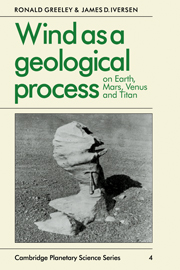Book contents
- Frontmatter
- Contents
- Preface
- 1 Wind as a geological process
- 2 The aeolian environment
- 3 Physics of particle motion
- 4 Aeolian abrasion and erosion
- 5 Aeolian sand deposits and bedforms
- 6 Interaction of wind and topography
- 7 Windblown dust
- Appendix A Nomenclature and symbols
- Appendix B Small-scale modeling of aeolian phenomena in the wind tunnel
- Glossary
- References
- Index
6 - Interaction of wind and topography
Published online by Cambridge University Press: 16 November 2009
- Frontmatter
- Contents
- Preface
- 1 Wind as a geological process
- 2 The aeolian environment
- 3 Physics of particle motion
- 4 Aeolian abrasion and erosion
- 5 Aeolian sand deposits and bedforms
- 6 Interaction of wind and topography
- 7 Windblown dust
- Appendix A Nomenclature and symbols
- Appendix B Small-scale modeling of aeolian phenomena in the wind tunnel
- Glossary
- References
- Index
Summary
Introduction
It is possible, as we have seen in the last chapter, for a sea of windblown sand to create its own topographical features in the form of sand dunes. In this chapter we discuss the interactions which occur between windblown particles and topographical features such as hills, craters (particularly as related to craters on Mars), vegetation, and other obstructions to the boundary layer. In order to understand these interactions, it is necessary to discuss atmospheric circulation and the effects that obstructions have on wind flow near the ground.
Some of the primary indicators of topographical influences are various types of wind streaks. Mariner 9 and Viking images of Mars show a remarkable array of bright and dark surface markings that result from interactions between the wind and topography (Fig. 1.3(a)). Many of these streaks serve as surface wind direction indicators. The differences in streak geometry and their variability with time have sparked much discussion and controversy on their origin and evolution. We review the streaks of Mars and discuss their possible origins, as well as present some possible terrestrial analogs that may shed light on the atmospheric–topographical interactions involved in streak formation.
Atmospheric motions
General atmospheric circulation results primarily from planetary rotation combined with the variation of incident solar flux with position on the planet (see Chapter 2). On a smaller scale, atmospheric circulation is influenced by topographical features such as mountain ranges, and on Earth is further influenced by the oceans through the exchange of heat and water vapor with the atmosphere.
- Type
- Chapter
- Information
- Wind as a Geological ProcessOn Earth, Mars, Venus and Titan, pp. 199 - 249Publisher: Cambridge University PressPrint publication year: 1985



